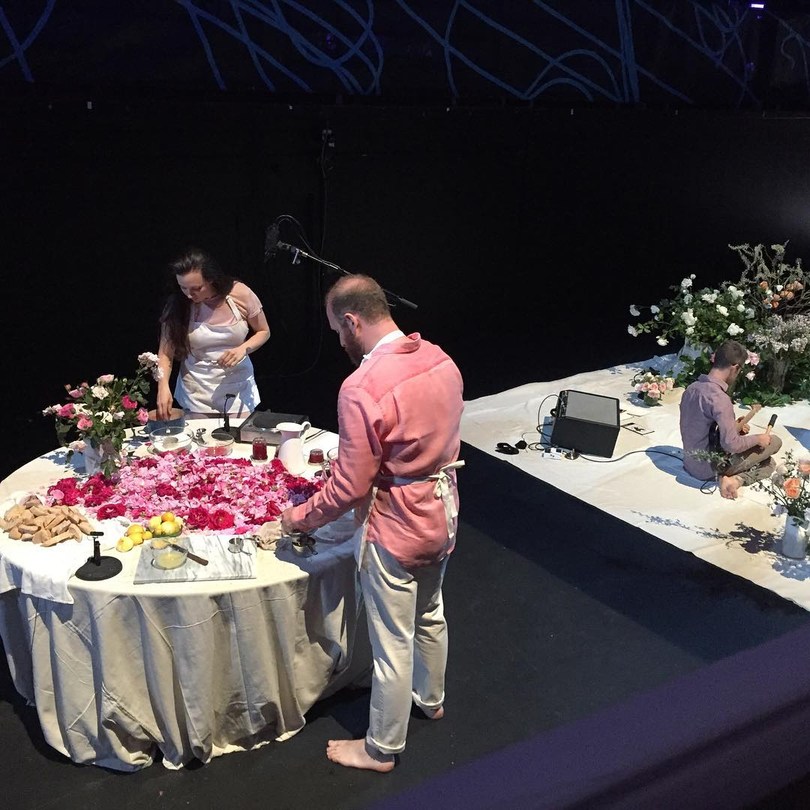SoundBox 2.2: Let There Be Tuba

The opening riffs of “Smoke on the Water” and “Whole Lotta Love,” the first four notes of Beethoven’s 5th and the anvils in Wagner’s Das Rheingold, the voices of Billie Holiday and Bon Scott — there are certain musical bits and sounds one never forgets after hearing them the first time. Add to that list the sound of Jeff Anderson playing an electric tuba through a Marshall half-stack. Those glorious few minutes, simultaneously sublime and grotesque (and I definitely mean that as a compliment), were the highpoint of the second SoundBox program of the second season of the San Francisco Symphony’s experimental series.
Curated by the Symphony’s musicians and led by Christopher Rountree (composer, conductor and founder of L.A.’s chamber orchestra wild Up) SoundBox 2.2, aka Hidden Worlds, offered a cornucopia of unusual sounds from orchestral musicians and their instruments: an amplified trio comprised of flute, cello and piano imitated the sound of whales in George Crumb’s Vox Balaenae; a piano and cello became The Little Train of the Caipira in a piece by Heitor Villa-Lobos; the orchestra submerged the audience into Camille Saint-Saën’s “Aquarium,” and broke out chopsticks (utensils, not the ditty) and broke flower pots during Oscillate, Andy Akiho’s exuberant, percussion-laden, funhouse.
Anderson’s electric tuba solo (played on a standard tuba with a Shure microphone lowered into the bell, amplified, and with pedal effects) was a sonic kick to the ears bursting with feedback and speed, coming in the middle of David Lang’s are you experienced, which also includes an appearance from the composer (via an impersonator), performed by a chamber orchestra without a single violin player. Lang’s piece (as well as Akiho’s) is the kind of musical experience perfectly suited to SoundBox, which ideally offers attendees the opportunity to encounter new music in a casual but sophisticated setting at low-cost. It’s working, evidenced by near instant sell-outs and rapt audiences, which are surprisingly quieter and better behaved than recent ones I’ve encountered in the main hall.
Now I’m beginning to wonder if the template’s been set, and if the Symphony is going to start playing it safe with their new hit. Unlike other concerts, I’ve deliberately made it a habit not to familiarize myself with the music on the program ahead of time because I want to be surprised – by the music, by the video projections, and how the night’s theme finds expression through both. I think it’s best to arrive at a SoundBox show with a minimum of expectations and be open to what’s offered, and each show has provided at least one “a-ha” moment (often several) along with memorable musical experiences. But last weekend it started to feel familiar.
I realize I’m probably one of the few people who’ve attended each program, and maybe it’s just a symptom of my own sometimes short attention span, but I still want a surprise every time I walk in the door, and a feeling of wow — that was different when I leave. I’m sensing that potential is beginning to slip away as SoundBox morphs from a risky experiment into a solid success. That’s okay, and maybe it’s an unreasonable expectation on my part, but I’m going to offer up this bit of unsolicited advice to the SoundBox folks: keep changing it, keep us guessing, and keep ahead of us. And give us more of that tuba.
Tickets for the next SoundBox (February 19 & 20) are on sale now. The title is “Transcendent” and the curator is Ragnar Bohlin, Music Director of the San Francisco Symphony Chorus. It promises “A thousand years of musical responses to war, beauty, and heartache.”
If you liked this, like A Beast on Facebook for more.





